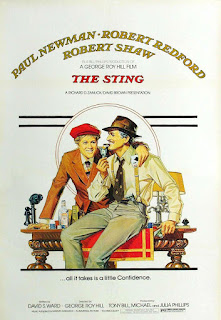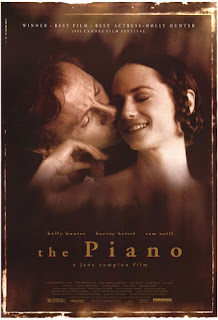January 24th: THE STING (George Roy Hill, 1973)
NOTE: This film will be projected in the high-definition Blu-ray format.
During the Great Depression, a young grifter seeks out a washed-up con artist to help get revenge on the crime boss who murdered his partner.
Screenwriter David S. Ward, a graduate of both USC and UCLA film schools, became fascinated with the world of pickpockets and con men, and spent much time researching the intricacies of their trades, as well as their environment in big cities in the 1930s, the workings of local law enforcement and the larger criminal underworld. He wrote a script loosely based on two prominent brothers who worked together on cons, with much attention to detail including the distinct vernacular spoken by similar types.
The script was sent to Robert Redford, who initially turned down the lead role because he thought Ward (set to direct) wasn't experienced enough to handle such an ambitious production. Veteran director George Roy Hill, who had recently worked with Redford on Butch Cassidy and the Sundance Kid, also read the script and persuaded the producers to let him take the helm. He brought Redford back onboard, which then attracted the attention of Paul Newman, making it a full Butch and Sundance reunion.
Hill polished the script with Ward, injecting a considerable amount of humor and streamlining the story. He put together a top-notch crew of Oscar winners, including cinematographer Robert Surtees (Ben-Hur, The Graduate), art director Henry Bumstead (Vertigo, To Kill a Mockingbird), and legendary costume designer Edith Head (All About Eve, To Catch a Thief).
Cast in the role of the main villain was Robert Shaw (Jaws), and the roster was filled with notable character actors, many with a background in the New York theatre: Charles Durning (Tootsie, O Brother Where Art Thou?), Eileen Brennan (The Last Picture Show), Ray Walston (Fast Times at Ridgemont High), Robert Earl Jones (Trading Places, Witness), and Harold Gould (TV's The Golden Girls).
The film was shot primarily on the Universal Backlot, with some location shooting in Los Angeles (the Biltmore Hotel, the Santa Monica carousel), as well as in Chicago where the story takes place (Union Station). Hill was known as a stern taskmaster, but did allow some improvisation and suggestion from his stars, and was thought of very highly by the cast and crew for his professionalism and attention to detail. He used a variety of old-fashioned visual gimmicks to highlight the story's setting, including page wipes, iris shots, and chapter title cards in the style of Normal Rockwell's covers for The Saturday Evening Post.
While Ward had envisioned a soundtrack filled with period blues songs, Hill heard some music from ragtime composer Scott Joplin, whose work had recently been rediscovered in the late 1960s due to the efforts of a young musicologist. Despite the music being popular 20+ years before the film's time period, Hill thought its upbeat nature fit the material perfectly. He enlisted composer Marvin Hamlisch (The Way We Were) to arrange Joplin's music for the film as well as contributing some of his own work.
The Sting was an enormous box office success, the second-highest moneymaker of the year behind The Exorcist. It increased the already-enormous stature of Newman and Redford, brought Joplin's music to a widescreen audience (the film's soundtrack went to #1 on the charts), and earned Academy Awards for Best Picture, Direction, Screenplay, Editing, Costume Design, and Art Direction, as well as a nomination for Redford.
Running time is approx. 2 hours.











Comments
Post a Comment